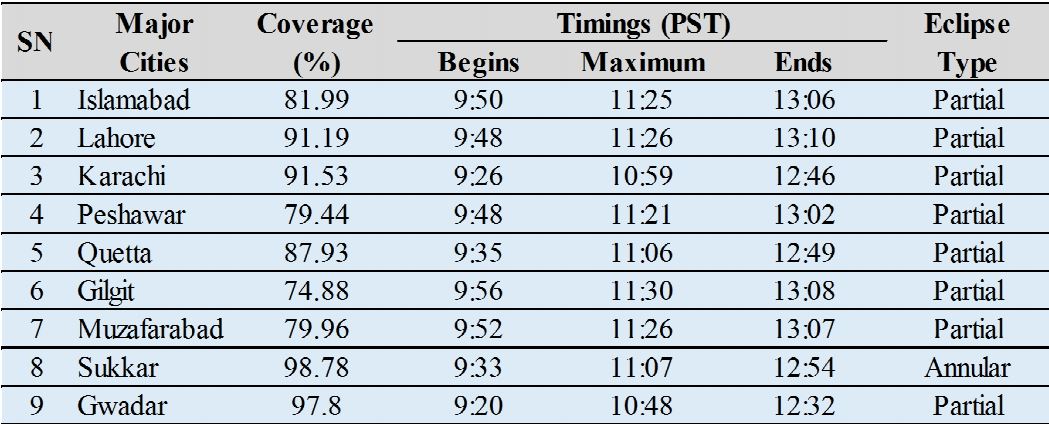Pakistan witnesses 'Ring of fire' solar eclipse

Pakistan witnesses 'Ring of fire' solar eclipse
KARACHI (Dunya News) - Skywatchers in Pakistan witnessed Sunday a dramatic "ring of fire" solar eclipse. Sukkar and Gawadar witnessed greatest phase of celestial spectacle with over 98 and 97 percent coverage respectively.
According to Pakistan Meteorological Department, the partial eclipse began at 8:46 in Pakistan and it will end at 14:34 with greatest eclipse occuring at 11:40. Karachi and Lahore witnessed over 91% coverage while Gilgit witnessed the lowest coverage at only 74%.
The eclipse at major cities of Pakistan and their corresponding timings are as follow:
Apart from Pakistan, annual eclipse is also visible from parts of Africa including Central African Republic, Congo, Ethiopia, Northern India and China.
Medical experts have advised not to look at the sun directly without using sunglasses with special filters as rays from the sun can cause damage to skin and eyes.
Annular eclipses occur when the Moon -- passing between Earth and the Sun -- is not quite close enough to our planet to completely obscure sunlight, leaving a thin ring of the solar disc visible.
They occur every year or two, and can only been seen from a narrow pathway across the planet.
Remarkably, the eclipse on Sunday arrives on the northern hemisphere’s longest day of the year -- the summer solstice -- when Earth’s North Pole is tilted most directly towards the Sun.
The annular eclipse is visible from about two percent of Earth surface," Florent Delefie, an astronomer and the Paris Observatory, told AFP.
"It’s a bit like switching from a 500-watt to a 30-watt light bulb," he added. "It’s a cold light, and you don’t see as well."
Good weather key
Animals can get spooked -- birds will sometimes go back to sleep, and cows will return to the barn.
The full eclipse will be visible somewhere on Earth during just under four hours, and one of the last places to see a partially hidden Sun is Taiwan before its path heads out into the Pacific.
People hundreds of kilometres on either side of the centreline across 14 countries will also see light drain from the day, but not the "ring of fire".
"Good weather is the key to successful eclipse viewing," astrophysicist Fred Espenak, an expert on eclipse prediction, commented on the NASA Eclipse website. "Better to see a shorter eclipse from clear sky than a longer eclipse under clouds."
A solar eclipse always occurs about two weeks before or after a lunar eclipse, when the Moon moves into Earth’s shadow. Lunar eclipses are visible from about half of Earth’s surface.
There will be a second solar eclipse in 2020 on December 14 over South America. Because the Moon will be a bit closer to Earth, it will block on the Sun’s light entirely.
It will take less than 100 minutes for the path of this eclipse to move across the continent.
Even if the day has darkened, looking at a solar eclipse with the naked eye is dangerous.
Sunglasses -- which don’t filter out UV rays -- do not offer any protection, Delefie warned.
"The Sun is so bright that even when there’s only a tiny portion visible, it is still dangerous for the eyes," he said.


